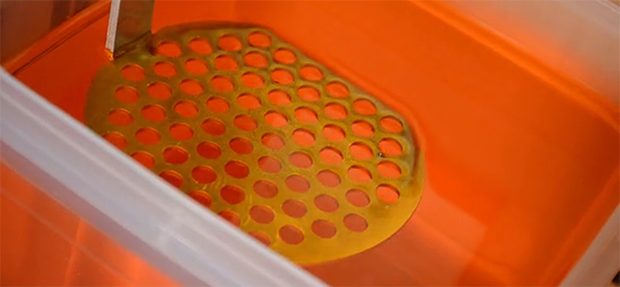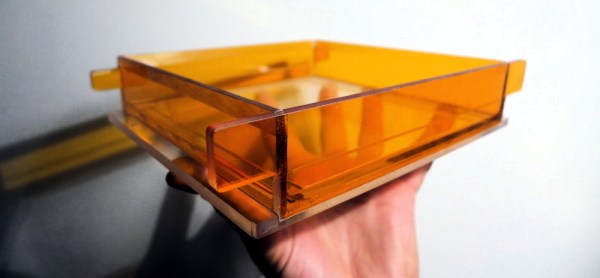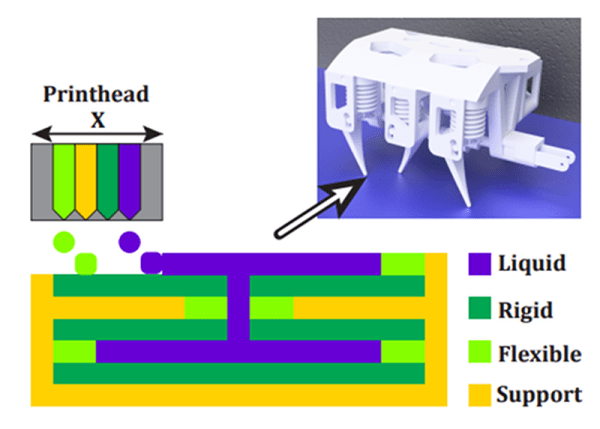Whilst designing hardware, it’s easy to shut the doors, close the blinds, and bury ourselves deeply into an after-hours design session. Although it’s tempting to fly solo, it’s likely that we’ll encounter bugs that others have handled, or perhaps we’ll realize that we forgot to add a handy feature that someone else could’ve noticed before we sent the darned PCB files out for fab. All that said, if we probe the community around us and ask for feedback, we can produce a project that’s far more functional and feature-complete in less time than if we were to design solo. Who knows? With enough eyes giving feedback on your project, maybe others will get excited enough to want one for themselves! [Andrew Werby] and [Zak Timan] on the FormLabs forums did just that: through months of iterative design and discussion on the FormLabs forums, they’ve created the first 3rd party glass resin tank that’s altogether sturdier, longer-lasting, more scratch-resistant, and less distorting than the original resin tank. And guess what? After months of trials through a few brave customers, you too can be the proud owner such a tank as they’re now up for sale on [Zak’s] website.
Continue reading “The Triumph Of Open Design And The Birth Of A FormLabs Aftermarket”
UV resin11 Articles
3D Printed Hydraulics
[Robert MacCurdy] at MIT wants to change how people think about hydraulics. Using fluid can be very useful in systems like robots, but it is often the case that the tubing that carries hydraulic fluid is not an integrated part of the overall design. [MacCurdy] and his colleagues have modified a 3D printer to allow it directly include hydraulic components as it prints.
The idea is simple. The team started with a printer that uses a liquid ink that is UV cured to produce solid layers. The printer has the ability to use multiple liquids, and [MacCurdy] uses hydraulic fluid (that does not UV cure) as one of the print materials. Just as you can use a 3D printer to build structures within other structures, printing the hydraulics allows for complex closed systems that use the UV-cured resin as mechanical parts that can transfer pressure to and from the hydraulic system.
The Beginning Of The Age Of 3D Resin Printers

For several years now, filament-based plastic printers have ruled the hobbyist market, with a new iteration on squirting plastic appearing on Kickstarter every week. SLA printers, with their higher resolution and historically higher price for raw materials, have sat in the background, waiting for their time to come.
Now, with the Sedgwick printer now available on Kickstarter, we may finally be seeing some resin printers make their way into hackerspaces and workshops the world over. Instead of other DLP projector-based resin printer where projector light shines up through the resin tank, the creator of the Sedgwick, [Ron Light] is doing things the old-fashioned way: shining the projector down onto the surface of the resin. He says it’s a simpler method, and given he’s able to ship a Sedgwick kit minus the projector for $600, he might be on to something.
There are a few other resin printers coming on the scene – the LittleSLA will soon see its own Kickstarter, the mUVe 1 is already shipping, and over on Hackaday Projects, the OpenExposer project is coming along nicely. All very good news for anyone who wants higher quality prints easily.
Hackaday Links: March 3, 2014
![]()
If you’re playing along with Twitch Plays Pokemon, you might as well do it the right way: with the smallest Game Boy ever, the Game Boy Micro. [Anton] needed a battery replacement for this awesome, discontinued, and still inexplicably expensive console and found one in a rechargeable 9V Lithium battery. You get two replacement cells out of each 9V battery, and a bit more capacity as well.
Every garden needs garden lights, right? What does every garden light need? A robot, of course. These quadruped “Toro-bots” react to passersby by brightening the light or moving out of the way. It’s supposed to be for a garden that takes care of itself, but we’re struggling to figure out how lights will do that.
Flexiable 3D prints are all the rage and now resin 3D printers are joining the fray. The folks at Maker Juice have introduced SubFlex, a flexible UV-curing resin. The usual resins, while very strong, are rock solid. The new SubFlex flexible resins are very bendable in thin sections and in thicker pieces something like hard rubber. We’re thinking custom tank treads.
Remember this post where car thieves were using a mysterious black box to unlock cars? Looks like those black boxes have moved from LA to Chicago, and there’s still no idea how they work.
Have a Google Glass? Can you get us on the list? [Noé] and [Pedro] made a 3D printed Google Glass adapter for those of us with four eyes.













